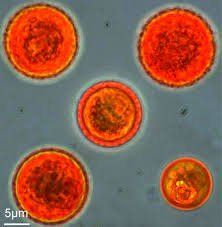Dunaliella

Dunaliella is a green algae. It is a single-celled creature that is able to exist in extreme conditions of heat and salinity, such as those found in the Dead Sea. In order to cope with the harsh environmental conditions, the cell produces substances that help it survive. These materials are used in the cosmetics and skin restoration industry.
Some of this algae ingredients are useful in creams, but they are also available from other sources. That is, the Dunaliella is not the only source from which we can get them. Examples of such ingredients: proteins, polysaccharides, lipids and fatty acids, glycerol, vitamins (thiamine, pyridoxine, riboflavin, nicotinic acid, biotin and tocopherol-vitamin E).
However, there is another component, which arouses interest among researchers as well, due to its uniqueness when it is extracted from Dunaliella algae. This is beta-carotene.
What is beta carotene?
Beta carotene is used in the body as a source of vitamin A. This vitamin is of utmost importance in the functioning of the skin. In addition, it is a source of retinoid, whose derivative – retinoic acid – is used as a powerful anti-aging treatment, and even as a treatment for acne and psoriasis. In natural stores you can find beta carotene as a food supplement. However, there is a fundamental difference between the supplement made from a synthetic material and the carotene extracted from Donaliella. The latter – consists of two isomers (chemical forms): all trans and 9cis. The synthetic carotene contains only one isomer: all trans. This mixed form of two isomers has substantial advantages over the synthetic derivative.
In fact, there is evidence that the food supplement containing synthetic carotene may even harm the body, and that it does not provide the body with the protection against cancer development and the antioxidant effect of natural carotenoids. The beta carotene derived from the Donalia algae, which contains the 9-cis form, differs from the synthetic derivative in three main characteristics: 1. It is more available to the body. 2. It has a much stronger antioxidant effect. 3. It is a precursor for the creation of retinoic acid, a substance with many biological functions, some of which are related to renewing the appearance and function of the skin.
Why should you adopt Donaliala seaweed as a source of beta carotene?
Beyond the preferred chemical form of beta-carotene produced from algae, it turns out that algae grown under harsh conditions of sunlight and other stress factors contain a high percentage of beta-carotene. Compared to algae grown under normal conditions, which contains about 0.3% beta carotene, algae that live in extreme conditions of exposure to the sun and other factors that threaten their existence, the amount of beta carotene can reach 10% of the dry weight of the algae. This substance helps the algae to survive and protects it from the sun’s radiation. Today, the Donalia algae is grown for commercial use, as a source of beta carotene and even proteins. In the Dead Sea there is a factory, owned by Japanese, where the Donaliala seaweed is grown for commercial use. A study taking place at Tel Hashomer Hospital examines the effect of using Donaliella (as a source of beta-carotene that breaks down into retinoic acid) in the treatment of psoriasis.
In the appropriate concentration, the use of this substance has the potential to improve the appearance and function of the skin when applied externally. The algae rich in beta carotene is orange in color.
Donalia algae – when it grows in harsh conditions of sunlight, it produces a high amount of beta carotene. Then its color is orange. In better growing conditions its color is green/blue.
